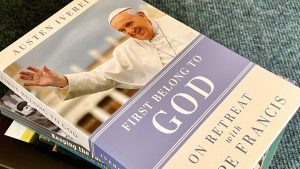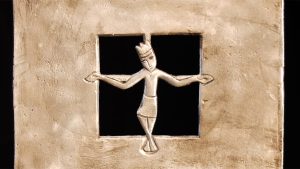Reflecting on the season of Advent
 While preparing Advent talks, Brendan Comerford found some interesting facts about the history of the celebration of Advent, in a very helpful article by Vincent Ryan OSB. Here are some of Brendan’s jottings.
While preparing Advent talks, Brendan Comerford found some interesting facts about the history of the celebration of Advent, in a very helpful article by Vincent Ryan OSB. Here are some of Brendan’s jottings.
Origins and development of Advent
When the feast of the nativity of the Lord was introduced to Rome in the early years of the 4th century, it was celebrated as a simple memorial and was not preceded by a period of preparation. It was not until the middle of the 6th century, by which time Christmas had become a major solemnity almost on a par with Easter, that the Roman Advent made its appearance.
It was outside of Rome, especially in Spain and Gaul, that the earliest form of Advent appears. The Council of Saragossa in Spain in 380 refers to a three-week period of preparation extending from 17th December to the feast of the Epiphany. It urges the faithful to be assiduous in going to church daily during this time. The Epiphany, like Easter, was a time for the conferring of baptism, and this suggests that the weeks of preparation were conceived mainly in function of the sacrament of initiation.
Towards the end of the 5th century in Gaul, the three-week period of preparation was extended to forty days. Beginning on the feast of St. Martin, 11th November, the period was known as the Lent of St. Martin. The name was well chosen for this season since it was strongly penitential in character and lasted forty days. By this time Christmas had replaced Epiphany as the terminus of the time of preparation.
The Roman Church did not see the need for a prolonged pre-Christmas fast such as existed in Spain and Gaul. When the season of Advent eventually made its appearance, it was liturgical rather than ascetical in character. From the start it was directly oriented to Christmas, not Epiphany, and took its whole meaning from that feast. It had no connection with baptism.
The primitive form of the Roman Advent had six weeks before Christmas. This is still the practice in the Milanese rite. It was during the pontificate of Pope St. Gregory the Great (590-604) that the number of weeks was reduced to four.
In its earliest form Advent was basically a preparation for Christmas. Within a fairly short time, however, it acquired an eschatological character – a time of waiting and expectancy for the return of the Lord in glory. This became a characteristic thrust of the Gallican liturgy, especially through the influence of the Irish monks who, in their preaching, laid such stress on the coming of the Lord in judgement and on the need to do penance.
The word Advent (Adventus) designated originally not the period of preparation, but the feast of Christmas itself. The coming of Christ in the flesh and the liturgical commemoration of that event was the adventus Domini, the advent of the Lord. Since in the New Testament the word adventus translated the Greek parousia, it was natural that in its Christian usage the term should include in its connotation the second coming of Christ at the end of time.
Origins and development of Advent (2)
As to its essential form and structure the development of the Roman Advent was completed by the 8th century. But it was to be profoundly influenced by the very different spirit of the Gallican Advent which as already noted, was profoundly penitential in character. The Roman Advent also included a note of penance, but in the positive sense of a call to conversion and renewal of life.
Among the most splendid additions to the Roman Advent were the O Antiphons or Greater Antiphons. They were in use in our western liturgy since the time of Charlemagne. They are attributed to an anonymous cantor of the 8th century.
It was only in the 8th and 9th centuries that the tradition was established of commencing the liturgical year with the first Sunday in Advent.
The Advent Wreath. Its origins go back to pre-Christian times, to the sun-worshipping tribes of northern Europe. It was one of the many symbols of light which were used at the end of November and early December, that time of year when our pagan ancestors celebrated the month of Yule by lighting torches and fires. To appease the sun-god and to ensure his return in the darkest time of the year, they took what may have been a cartwheel, wound with green and decorated with lights, and offered it to the deity.
It was in the 16th century in eastern Germany that the custom was Christianised and the Advent wreath made its appearance in people’s homes as a religious symbol of Advent. Its adoption in English speaking countries is witnessed only in recent times. The wreath itself, symbol of victory and glory, symbolises the fullness of time, the birth of Christ and the glory of his coming.
Irish people expressed their devotion to Mary during Advent by a more frequent recitation of the rosary (Coroin Mhuire, Mary’s Crown). The ideal was to attain a total of four thousand Hail Mary’s before Christmas!
The General Norms for the Liturgical Year and Calendar declare Advent to be a ‘season of joyful and spiritual expectation’ and that it is ‘no longer to be considered a penitential season’. Some vestiges of the older observance do remain, such as the suppression of the Gloria at Sunday Mass and the wearing of purple vestments. Both these practices were transmitted from Gaul to Rome in the 12th century. The commentary explains that the Gloria is dropped ‘in order to allow it to ring out with certain freshness at Christmas’, and, likewise, the sobriety of colour will make the white vestments appear all the more brilliant on Christmas day.
Two parts of Advent can be clearly distinguished, each with its own significance, as the prefaces clearly illustrate. From the first Sunday of Advent until December 16th the liturgy expresses the eschatological character of Advent and urges us to look forward to the second coming of Christ. From
Origins and development of Advent (3)
Decemeber 17-24, the daily propers of the Mass prepare more directly for the celebration of Christmas.
The first two Sundays announce the coming of the Lord in judgement, the third expresses the joy of a coming already very near, the fourth and last ‘appears as a Sunday of the fathers of the Old Testament and the Blessed Virgin, in anticipation of the birth of Christ’. (Commentary on the Roman Calender, section 2).












